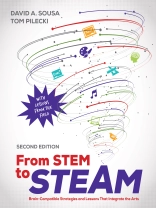Art and science both hinge on discovery, and discovery requires thinking out of the box. But how do you lead students to think creatively in STEM education? The answer is STEAM, and A is for the arts.
STEAM—the integration of music, visual arts, and drama into daily STEM instruction—is proven to enhance student achievement in STEM subjects. After all, creative, real-world problem-solving is what working scientists and mathematicians actually do. But how do busy STEM educators weave arts activities into a sometimes inflexible STEM curriculum?
In this new edition of From STEM to STEAM, the ground-breaking bestseller, the authors provide lessons from the field to detail the way. Authors David Sousa, expert in educational neuroscience, and Tom Pilecki, veteran arts educator, pool theircombined eighty years of expertise to deliver:
- Research studies in cognitive and social neuroscience, including new findings on how technology is rewiring students’ brains, that demonstrate how arts activities enhance creativity, problem solving, memory systems, motor coordination, and analytical skills—all critical elements to achieving STEM objectives.
- Classroom-tested strategies and techniques for integrating the arts into STEM instruction, including sample K-12 lessons plans and planning templates.
- Tools for building a professional development program designed to helps arts and STEM teachers collaborate to create STEAM lessons.
- Sample planning frameworks that provide a smooth transition from STEM to STEAM, including advice on adapting STEAM to meet the individual needs and limitations of a school or district.
- A list of resources available to teachers in the STEM subjects, in the arts, in arts integration, and for STEAM.
The main objective of both art and science is discovery. Lead your students to make that connection and STEAM ahead to academic success!
Cuprins
ACKNOWLEDGMENTS
ABOUT THE AUTHORS
INTRODUCTION
Why a Second Edition?
What’s New?
Looking to the Arts
How This Book Can Help to Implement STEAM
Chapter Contents
Who Should Use This Book?
What’s Coming?
1. Why STEM Should Become STEAM
The Power of the Arts
The Arts and STEM Do Have Differences
What’s Coming?
Major Points to Ponder
2. What Science Says About the Arts and Creativity
Brain Organization
Thinking and Learning
The Arts, STEM, and Creativity
What’s Coming?
Major Points to Ponder
3. Bringing STEAM Into Schools
What Is Arts Integration?
What Is STEAM?
Different Schools and Implementation Formats
Implementing the STEAM Initiative
The Basic District Plan
What We Are Learning
What’s Coming?
Major Points to Ponder
4. Guidelines for Creating a STEAM School
STEAM Guidelines
What’s Coming?
Major Points to Ponder
5. Frequently Asked Questions About Integrating the Arts and STEM
What Are the Arts?
Addressing Some Common Frequently Asked Questions
Arts Perception Worksheet
What’s Coming?
Major Points to Ponder
6. Implementing Arts Integration in the Primary Grades (K–4)
Importance of Movement
Science, Mathematics, and the Arts in the Primary Grades
Ideas for Arts-Integrated Lesson Plans (Primary Grades)
What’s Coming?
Major Points to Ponder
7. Implementing Arts Integration in the Intermediate Grades (5–8)
A Day in the Life of a Middle School Student
Teacher-to-Teacher Collaborations
What’s Coming?
Major Points to Ponder
8. Implementing Arts Integration in the High School Grades (9–12)
STEAM and the Culture of High School
Pushing STEAM Along
Sample Comparisons of Traditional STEM and Arts-Integrated STEAM Lessons
What’s Coming?
Major Points to Ponder
9. Discoveries From the Field
About the Original Appetizers
What’s Coming?
Major Points to Ponder
10. Putting It All Together
Know Your Instructional Intuition
General Guidelines for K–12 Lessons
Sample K–12 Lessons: Examples of Arts-Related Activities in Science Topics
Sample Template for Designing a STEAM Unit Across Grade Levels
Professional Development to Maintain STEAM
Conclusion
Major Points to Ponder
RESOURCES
APPENDIX A: STEAM LESSON PLAN APPETIZERS IN SCIENCE, TECHNOLOGY, AND ENGINEERING
The Appetizers
APPENDIX B: STEAM LESSON PLAN APPETIZERS IN MATHEMATICS
The Appetizers
REFERENCES
INDEX
Despre autor
Tom Pilecki, MA, is the former executive director of the Center for Creative Education (CCE) in West Palm Beach, Florida, where, for twelve years, he provided professional development to over one hundred teaching artists, preparing them to teach collaboratively with elementary and middle school teachers in all curriculum content areas. With an MA in educational administration, Tom is a former elementary school teacher as well as a choral and instrumental music teacher. His forty-plus years in education include being founder and principal of St. Augustine School of the Arts in the South Bronx, New York, the subject of the Sundance Film Festival Award-winning documentary Something Within Me as well as feature segments on 60 Minutes, World News Tonight, and The Mc Neil-Lehrer Report. His expertise in curriculum writing, implementation, and arts integration brought him to Chicago as curriculum director for six West Side schools before going to Florida. He continues to consult with schools and communities on a national basis.












